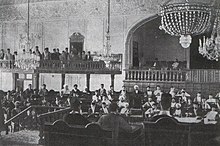1908 bombardment of the Majlis

The 1908 bombardment of the Majlis of Iran (Persian: به توپ بستن مجلس) took place on 23 June 1908 in
History

During the constitutional revolution, the Shah confined himself to his residence at the Bagh-e Shah fort in the west of Tehran. He enlisted the help of the Cossack Brigade to control the revolution, leaving the city of Tehran at their mercy.[5][4] The loyalty of the Cossack Brigade was fully guaranteed, not only by the previous purge carried out by commander Vladimir Liakhov, but also by the king's distribution of a special bonus in 1908.[6]
Russian colonel Vladimir Liakhov, the commander of the Cossack Brigade, led the force in shelling the Majles and executing several leaders of the Constitutional Movement on June 23, 1908. His forces then plundered the parliament and damaged the building.[5] This event lead to the beginning of a period known as the "Minor Tyranny." Liakhov was subsequently made Military Governor of Tehran by the Shah, transforming the city into a military garrison.[5]
However, in July 1909, pro-Constitution forces marched from Iran's province of Azerbaijan to Tehran. They were able to capture Tehran, depose the Shah and re-establish the constitution. Colonel Liakhov and his forces served the Shah until July 1909, when the Shah abdicated and fled to Russia, resulting in the surrender of Liakhov and the Persian Cossack Brigade. Liakhov was pardoned by the Constitutional leaders probably for the fear of a Russian attack and was sent back to
Gallery
-
Mohammad Ali Shah Qajar, who was Shah of Iran at time of 1908 Tehran bombardment and wanted to subdue Majlis.
-
Colonel Liakhov, Commander of Persian Cossack Brigade, responsible for 1908 Tehran bombardment.
-
Majles.
-
The Majlis building after the bombardment by the Cossack Brigade under the command of Colonel Liakhov, 1908
See also
References
- ISBN 978-1860641053.
On 23 June the brigade, commanded by Liakhov and the other Russian officers, bombarded and suppressed the Majlis
- ISBN 90-04-09738-4. p. 285-286
- ^ Mackey, Sandra The Iranians : Persia, Islam and the Soul of a Nation, New York : Dutton, c1996. p.150-55
- ^ a b BBC Persian
- ^ a b c d "Cossack Commander In Charge of Tehran - Russians Bombard Iranian Parliament". Archived from the original on 2016-08-26. Retrieved 2010-10-29.
- ISBN 978-1860641053.




